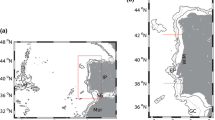Abstract
The regional ocean model system (ROMS) is used to downscale a 26-year period of the twentieth century 20C3M experiment from the global coupled Bergen climate model (BCM) for the North Sea. Compared to an observational-based climatology, BCM have good results on the mean temperature, except for too low winter temperature. This is connected to a too weak inflow of Atlantic water. The downscaling gives added value to the BCM results by providing regional details, doubling the Atlantic inflow, and improving the mean winter temperature. For mean salinity, BCM has values very close to the climatology, whereas the downscaling becomes too fresh. The downscaling, however, improves the sea surface salinity, the vertical structure, and the Norwegian Coastal Current. It is concluded that the downscaling procedure as presented here is a suitable tool for assessing the future Atlantic inflow and sea temperature in the North Sea based on a global climate projection.
Similar content being viewed by others
References
Ådlandsvik B (2005) Aspects of validation of a North Sea Model. In: Iversen T, Lystad M (eds) RegClim general technical report, vol 8. Norwegian Meteorological Institute, pp 83–93
Ådlandsvik B, Budgell WP (2003) Adapting the regional ocean model system for dynamic downscaling. In: Iversen T, Lystad M (eds) RegClim general technical report, vol 7. Norwegian Meteorological Institute, pp 49–57
Bentsen M, Drange H (2000) Parameterizing surface fluxes in ocean models using the NCEP/NCAR reanalysis data. In: Iversen T, Høisaker BAK (eds) RegClim general technical report, vol 4. Norwegian Meteorological Institute, pp 149–158
Bleck R, Rooth C, Hu D, Smith LT (1992) Salinity-driven thermocline transients in a wind- and thermohaline-forced isopycnic coordinate model of the North Atlantic. J Phys Oceanogr 22:1486–1505
Damm P (1989) Klimatologischer Atlas des Salzgehaltes, der temperatur und der Dichte in der Nordsee, 1968–1985. Tech rept 6–89. Institut für Meereskunde der Universität Hamburg
Delhez EJM, Damm P, de Goede E, de Kok JM, Dumas F, Gerritsen H, Jones JE, Ozer J, Pohlmann T, Rasch PS, Skogen M, Proctor R (2004) Variability of shelf-seas hydrodynamic models: lessons from the NOMADS2 project. J Mar Syst 45:39–53
Engedahl H, Ådlandsvik B, Martinsen EA (1998) Production of monthly mean climatological archives for Nordic Seas. J Mar Syst 14:1–26
Ezer T, Arango HG, Shchepetkin AF (2002) Developments in terrain-following ocean models: intercomparisons of numerical aspects. Ocean Model 4:249–267
Flather RA (1976) A tidal model of the northwest European continental shelf. Memoires de la Societe Royale des Sciences de Liège 6:141–164
Furevik T, Bentsen M, Drange H, Kindem IKT, Kvamstø NG, Sorteberg A (2003) Description and validation of the Bergen climate model: ARPEGE coupled with MICOM. Clim Dyn 21:27–51
Jones JE (2002) Coastal and shelf-sea modelling in the European context. Oceanography and marine biology: an annual review, vol 40. CRC Press, pp 37–141
Large WG, McWilliams JC, Doney SC (1994) Oceanic vertical mixing: a review and model with a nonlocal boundary layer parameterization. Rev Geophys 32:363–403
Lenhart HJ, Pohlmann T (2004) North Sea hydrodynamic modelling: a review. Senckenberg Marit 34:53–88
Levitus S (1982) Climatological atlas of the world ocean. NOAA Prof Pap 13
Marchesiello P, McWilliams JC, Shchepetkin AF (2001) Open boundary conditions for long-term integration of regional ocean models. Ocean Model 3:1–20
O’Brien CM, Fox CJ, Planque B, Casey J (2000) Climate variability and North Sea cod. Nature 142
Otto L, Zimmerman JTF, Furnes GK, Mork M, Sætre R, Becker G (1990) Review of the physical oceanography of the North Sea. Netherlands J Sea Res 36:161–238
Reid PC, Edwards M, Beaugrand G, Skogen M, Stevens D (2003) Periodic changes in the zooplankton of the North Sea during the twentieth century linked to oceanic inflow. Fish Oceanogr 12:260–269
Rodhe J (1998) The Baltic and North Seas: a process-oriented review of the physical oceanography. In: Robinson AR, Brink KH (eds) The sea, vol 11. Wiley, pp 699–732
Sætre R, Aure J, Danielsen DS (2003) Long-term hydrographic variability patterns off the Norwegian coast and in the Skagerrak. ICES Mar Sci Symp 219:150–159
Shchepetkin AF, McWilliams JC (1998) Quasi-monotone advection schemes based on explicit locally adaptive dissipation. Mon Weather Rev 126:1541–1580
Shchepetkin AF, McWilliams JC (2003) A method for computing horizontal pressure-gradient force in an oceanic model with a non-aligned vertical coordinate. J Geophys Res 108:1–34
Shchepetkin AF, McWilliams JC (2005) The regional ocean modeling system: a split-explicit, free-surface, topography-following coordinates ocean model. Ocean Model 9:347–404
Smith JA, Damm PE, Skogen MD, Flather RA, Pätsch J (1996) An investigation into the variability of circulation and transport on the north-western european shelf using three hydrodynamic models. Deutsche Hydrographische Zeitschrift 48:325–347
Song YT, Haidvogel DB (1994) A semi-implicit ocean circulation model using a generalized topography-following coordinate system. J Comput Phys 115:228–244
Sundby S (2000) Recruitment of Atlantic cod stocks in relation to temperature and advection of copepod populations. Sarsia 85:277–298
Umlauf L, Burchard H (2003) A generic length-scale equation for geophysical turbulence models. J Mar Res 61:235–265
Wiltshire KH, Manly BFJ (2004) The warming trend at Helgoland Roads, North Sea: phytoplankton response. Helgol Mar Res 58:269–273
Winther NG, Johannesen JA (2006) North Sea circulation: Atlantic inflow and its destination. J Geophys Res 111:C12018. doi:10.1029/2005JC003310
Author information
Authors and Affiliations
Corresponding author
Additional information
Responsible editor: Phil Dyke
Rights and permissions
About this article
Cite this article
Ådlandsvik, B., Bentsen, M. Downscaling a twentieth century global climate simulation to the North Sea. Ocean Dynamics 57, 453–466 (2007). https://doi.org/10.1007/s10236-007-0125-2
Received:
Accepted:
Published:
Issue Date:
DOI: https://doi.org/10.1007/s10236-007-0125-2




